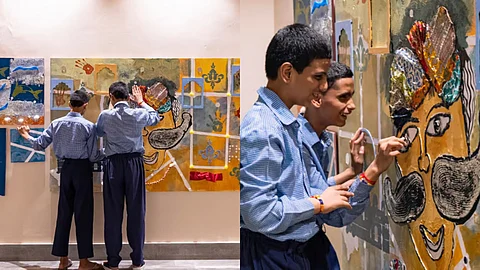
- HOMEGROWN WORLD
- #HGCREATORS
- #HGEXPLORE
- #HGVOICES
- #HGSHOP
- CAREERS
- ABOUT US
- CONTACT US

On a recent visit to the Indian Museum in Kolkata, I noticed something that I had never noticed before. In some of the galleries, there were tactile, three-dimensional relief replicas of many exhibits that people could touch, and feel, and perceive non-visually. And there were a group of young sightless and partially-sighted students who were engaging with the artworks in the Bengal gallery through these relief replicas. It made me wonder: what does it mean to experience art?
The history of art is the history of human civilisation. The earliest known works of art were created almost 50,000 years ago in the limestone caves of Leang Karampuang in the Maros-Pangkep region of South Sulawesi, Indonesia. It was a painting of a wild boar and three hunters — an abstract representation of the world around the person or persons who made the painting. These ancient cave paintings were precursors to both language and art as we know today. The history of art, then, is also the history of visual culture.
From the written words we use to communicate with each other to the arts, film, literature, and even music, the human world is largely a visual world. For the vast majority of us, vision is the primary sense — it is how we perceive the world and engage with it. From reading literature, watching films, and looking at artworks, our ability to see is what allows us to experience art. But what of the 2.2 billion people across the world who are visually impaired?
Until recently, the world of art was largely inaccessible to the billions of people who live with any kind of visual impairment. But with arts organisations and practitioners finally confronting the question of accessibility in cultural spaces beyond wheelchair access, that grim reality is slowly changing.
In recent years, the Serendipity Arts Festival has confronted the visual-first nature of contemporary arts with shows like 'Touched!', a tactile art experience that encourages the audience to use their hands and other senses to experience the work intimately.
"Through Touched!, we aim to highlight the beauty and depth of the tactile experience. It’s about more than just representing objects or scenes — it’s about carefully crafting surfaces that invite exploration and allow us to be immersed in the art object differently, more personally, and to be touched profoundly by the experience," curator Salil Tripathi wrote in his statement for the show.
The Serendipity Arts Foundation has been at the forefront of this homegrown tactile art movement. Previously, the Foundation collaborated with the Mumbai-based organisation, Access for All, to make tactile replicas of exhibits featured at the festival available and accessible to visually-impaired visitors.
Other arts organisations like St+art India Foundation have also engaged with tactile art through initiatives like Project Sparsh. Created in collaboration with Asian Paints, it unveiled a first-of-its-kind art museum featuring tactile murals, Phad paintings, and textiles with Bandhej and Bagru block prints at the Rajasthan Netraheen Kalyan Sangh School in Jaipur last year. The indoor exhibition aims to engage all senses, allowing the visually impaired students to explore and interact with the artworks in a truly immersive way.
This renaissance in accessible arts spaces and experiences is not only limited to organisations like St+art and Serendipity Arts Foundation. Government institutions like the Indian Museum in Kolkata and National Museum in New Delhi are also slowly making their collections more accessible to visually-impaired people. With the passing of the Rights of Persons with Disabilities Act 2016, the National Museum opened a tactile gallery called Anubhav in collaboration with UNESCO and Saksham Trust, a visual disability rights NGO, which claims to have “22 tactile replicas of museum objects (…) ranging from archaeological finds, sculptures, tactile impressions of paintings, utilitarian objects, ethnographic objects and decorative arts” on display.
Learn more about Project Sparsh here.
